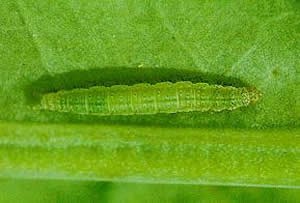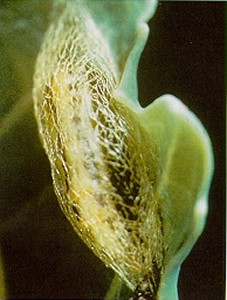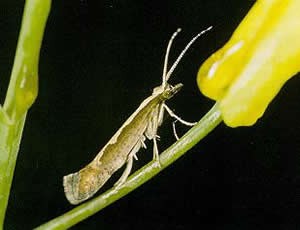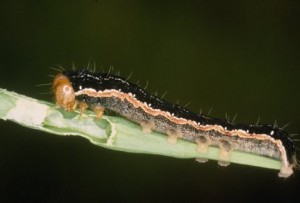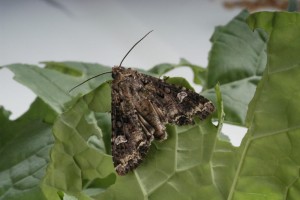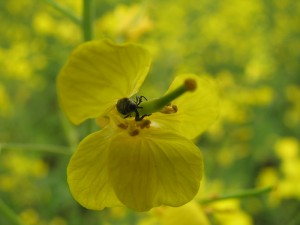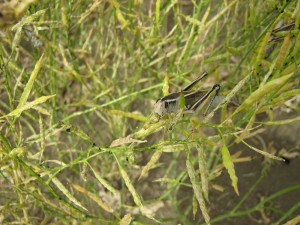Diamondback moth (Plutella xylostell) - The diamondback moth does not overwinter successfully in Saskatchewan. Economic infestations are usually the result of moths blown in on wind currents in the spring from the southern United States and Mexico. The amount of damage diamondback moth causes to mustard crops primarily depends on the part of the plant attacked, and the abundance and size of the larvae attacking the plants. Diamondback moth larvae feed on leaves, flowers, seed pods, the green outer layer of the stems, and the developing seeds within the older seed pods of canola and mustard. The amount of damage varies greatly, depending on plant growth stage, and larval density and size.
Diamondback moth develops through four life stages: egg, larva, pupa and adult. During the growing season this life cycle is repeated, with three generations being common if the moths arrive early and climatic conditions are favourable. It can take 21 to 51 days to complete one generation. After the first, the generations usually overlap in the field and in later generations all four life stages may be present in a field at the same time.
The adult moth is approximately 8 to 9 mm long with a wing span of 12 to 15 mm. The males have a series of yellowish wavy markings along the forewing margins that, when at rest, come together to form diamond-shaped marks.
The larvae are pale yellowish-green to green and covered with fine, scattered, erect hairs. Young larvae are leaf miners, feeding between the leaf surfaces. After about a week, the larvae start feeding externally on the leaves. At maturity the larvae are spindle-shaped and about 12mm in length. When disturbed, larvae wriggle backwards violently and may drop from the plant suspended by silken threads. The larvae eventually climb back onto the leaf and continue feeding.
There are naturally occurring wasp parasites, predators and disease that can reduce diamondback moth populations. High levels of parasitism are common in later generations of the insect.
Heavy precipitation events can have a significant negative impact on diamondback moth larvae. Fields should be scouted before considering chemical application for diamondback moth larvae following a heavy rain. Insecticides will have little or no effect on pupae. In addition, the pupae are often on the underside of leaves where contact is unlikely. Since the moths tend to lay their eggs in a short period of time (24 to 48 hours), targeting the moths is of little benefit. Eggs and young larvae that are leaf “mining” within the leaf are also not affected by an insecticide. The open feeding larvae are the best stage for control.
Action threshold for insecticide application (based on crop stands averaging 150 to 200 plants/m2):
- Insecticide application should be considered when plants are in the seedling or rosette stage and there is 25 to 33 per cent defoliation with larvae still present.
- Immature and flowering fields:100 to 150 larvae/m2
- Flowering and podded fields: 200 to 300 larvae/m2
In areas where stands are thinner, the action threshold should be adjusted accordingly.
Bertha armyworm (Mamestra configurata) - Outbreaks of bertha armyworm tend to last two to three years in an area and occur every eight to 10 years. Parasites, viruses and fungal disease contribute to the end of an outbreak period.
Bertha armyworm overwinters in the pupal stage in the soil. The adult moths emerge about mid-June to mid-July depending on heat development in the spring. In late July and August larvae feed on vegetative parts of the plant; later feeding on the flowers and pods occurs during the last larval instars.
There is one generation of bertha armyworm per year. Newly hatched larvae are pale green. Larvae pass through six instars and may be in a variety of colour phases of green and pale brown. At maturity, larvae are large (4 to 6 cm long) velvety black caterpillars with a light brown head and a broad pale orange stripe along each side. It is the later instars that cause the majority of the damage. Larvae chew irregularly shaped holes in leaves, and will cause direct yield loss by chewing into pods and flowers.
Bertha armyworm moths can be monitored using pheromone traps that catch male moths. Trap numbers provide an indication of numbers of moths in an area prior to emergence of the damaging larval stage. An annual bertha armyworm monitoring program using pheromone traps is conducted by the Government of Saskatchewan each summer; weekly updates can be viewed at their website during the time of surveys (June-August) and final map results can be viewed throughout the rest of the year. Populations in Saskatchewan are apparently on the rise.
Scouting larval populations requires making counts at several locations in a field. At each location, mark out an area one metre square (m2 ) and shake the plants growing within that area to dislodge the larvae. Count the number of larvae in the m2 area, including any hiding under soil and leaf litter. Use the average number of larvae at the sites surveyed within each field to determine if the economic threshold has been exceeded and an insecticide is necessary. If an insecticide application is necessary, be aware of the pre-harvest interval associated with the product. Since bertha armyworm infestations commonly occur later in the season, it is important to adhere to restrictions to prevent excess residues that could affect export of the commodity. Application should be done later in the day to avoid negative impacts on pollinators. The following table indicates the economic thresholds for different combinations of expected seed value and spraying costs to be used as a guide (the information is adapted from research conducted on Argentine canola but can be applied to mustard due to the similarities between the two crops). For example, if the current seed value is $10/bu, and estimated spraying cost of the insecticide is $8/ac, then deciding to spray for bertha armyworm would make economic sense when there is an average of 14 larvae/m2 or more.

Cabbage seedpod weevil (Ceutorhynchus obstrictus) - The adult cabbage seedpod weevil is an invasive small, ash-grey beetle, 3 to 4 mm long. They are hard-bodied insects with a long snout. The larvae are white, grub-like organisms that feed within the seedpod of the host plants – cruciferous crops and weeds. The cabbage seedpod weevil distribution is primarily in southern Saskatchewan but working its way north. Originally entering Saskatchewan in 2000 in the southwest, it has expanded its range eastward and north into central regions.
There is one generation of cabbage seedpod weevils per year. They overwinter as adults and emerge in the spring migrating from weeds into host crops when temperatures increase and the plants begin to flower. Early in the season, they feed on vegetative growth. After mating, the females lay eggs in developing pods. After hatching, the larvae feed within the developing pod consuming seeds. At maturity, the larvae exit through the pod wall, dropping to the ground to pupate. This can allow entry for disease and may result in premature shattering of the pod. Later, the emerging adults will feed on the plants causing additional damage.
Only brown and oriental mustard varieties require monitoring and potentially insecticide control of the weevil. Yellow mustard (Sinapis alba) is considered resistant. A sweep net is required to estimate numbers of cabbage seedpod weevils in a field. Monitoring should begin at the early bud stage through the flowering stage. Choose 10 sites within each field and estimate the average number of weevils per sweep. An economic threshold of 25 to 40 weevils per 10 sweeps on average is recommended as a level at which control measures may be required. Infestations will be more concentrated in field margins early in the season. Control measures may only be needed in certain areas and not necessarily across the field. An insecticide should be applied at about 10 to 20 per cent bloom. Application too early may result in reinvasion from overwintering sites. Insecticides should be applied later in the day to avoid pollinators and beneficial insects that are more active during the day.
Other minor insects - Aphids, blister beetles, cabbage loopers, imported cabbageworms and occasionally grasshoppers.
< Previous: Pest Control: Insects: Pests of seedlings
